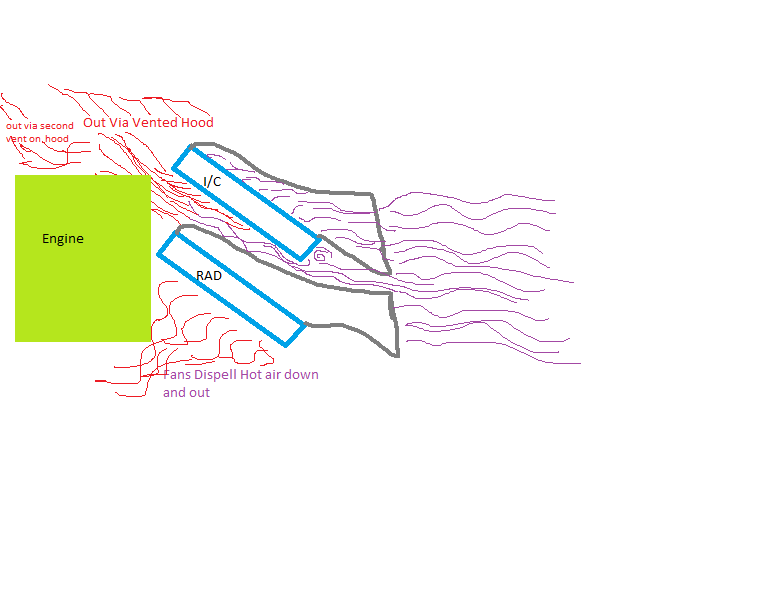How hot is too hot when at the track?
#51
manny, please dont take this as sarcastic hatred, but have you verified that that double-stack intercooler/radiator setup will work well in high heat in a track situation and actually push air through both and underneath the car? i am having trouble visualizing how that will happen.
i like the oil cooler fan idea. however, i've never been in a situation where my oil temps skyrocketed while sitting in the grid waiting to go onto the track. i understand it's hotter where you live, but how long are you all sitting on the grid with your cars running? we get a 10 minute warning, then we line up and we're out on the track...
No offense taken what so ever. I'll have to draw the set up do you can see better. But no.I have yet to hit the track with this set up. The air out of the radiator has a straight shot out under the car. But I'll have to see if an under panel will help.
The "stack" idea came from a wtac car and it worked very well the first outing on the dyno. Also took it out for break in miles in the 98° desert heat last summer and temp didn't budge. Sometimes we "stage" for 20-30 min before we can hit it. I've seen temps up to 118° out there before....So imagine the black top. The fans are for cool down staging and anytime it's hot.
#52
The CF ducts pictured on the previous page are the CWR (Crooked Willow) ducts I referred to with my kit. No longer available, but are what kits SHOULD come with today. Duane made '99 ducts too, but they were rarely sold and I tried to buy the bucks for them at one point, but wasn't successful.
Also, I'm sorry to whomever above, but NO, canyon runs and other street driving are NOT likely to tax the cooling system anything like what the track will—especially a track with lots of WOT throttle time. I doubt you can replicate 20-40 minutes of prolonged throttle time on a public road to replicate intense circuit driving. No offense.
Also, I'm sorry to whomever above, but NO, canyon runs and other street driving are NOT likely to tax the cooling system anything like what the track will—especially a track with lots of WOT throttle time. I doubt you can replicate 20-40 minutes of prolonged throttle time on a public road to replicate intense circuit driving. No offense.
#53
Make sure your undertray is in good shape or sealing nicely at the bottom of the radiator and also add some extra duct pieces to either side of the oem duct to block those openings
Add a second oil cooler if you don't have one and make sure they are both well ducted.
I have the oem dual oil coolers but replaced the lines with braided ones. Are these sufficient for the track or do I need aftermarket ones?
Off topic: Due to v-mount my aircon doesn't work, it has gas and everything is fitted. I've read something about placement of the canister/reservoir/condenser or whatever it's called....
Pic of under my car:

#54
^it's not so much a problem of not having an undertray as it is having proper ducting. If you can custom fab up a shroud for those rad fans, you should be good, at least when the fans kick on.
You should already have proper ducting for your VMIC setup in order for the airflow to be directed at the IC or rad accordingly. Same thing goes for you oil coolers, you need ducting.
You should already have proper ducting for your VMIC setup in order for the airflow to be directed at the IC or rad accordingly. Same thing goes for you oil coolers, you need ducting.
#55
#56
Thread Starter
Top of the food chain!!!
iTrader: (1)
Joined: May 2005
Posts: 1,012
Likes: 45
From: North Dallas, TX
Finally moved my 250lb tower speakers from the garage into the listening room so I can park the car in there again and work on it.
I'm going to do a drain and refill on the coolant because I think I'm running WAY too much coolant and not enough water. I think this should help substantially.
From looking at the surrounding area I can see the previous owner did make an effort to get some proper ducting going for the radiator. It's a bit flimsy but it's better than nothing. I won't know how fancy I need to get till I change the coolant/water ratio and get the front bumper off.
I'm going to do a drain and refill on the coolant because I think I'm running WAY too much coolant and not enough water. I think this should help substantially.
From looking at the surrounding area I can see the previous owner did make an effort to get some proper ducting going for the radiator. It's a bit flimsy but it's better than nothing. I won't know how fancy I need to get till I change the coolant/water ratio and get the front bumper off.
#57
All out Track Freak!
iTrader: (263)
Joined: Jul 2001
Posts: 10,672
Likes: 412
From: Charlottesville VA 22901

I still need a diff cooler I don't think the high capacity cover is getting the job done and hopefully it won't leak this weekend.
#58
All out Track Freak!
iTrader: (263)
Joined: Jul 2001
Posts: 10,672
Likes: 412
From: Charlottesville VA 22901
I have a custom v-mount and both 93 and 99 undertrays do not fit. Even if I butchered them to fit or another tray made it'd be too close to the radiator and/or the radiator fans almost blocking the back of them. I've been driving without a tray but haven't taken the car to the track yet. Is it ok to do a trackday without the tray?
I have the oem dual oil coolers but replaced the lines with braided ones. Are these sufficient for the track or do I need aftermarket ones?
Off topic: Due to v-mount my aircon doesn't work, it has gas and everything is fitted. I've read something about placement of the canister/reservoir/condenser or whatever it's called....
Pic of under my car:

I have the oem dual oil coolers but replaced the lines with braided ones. Are these sufficient for the track or do I need aftermarket ones?
Off topic: Due to v-mount my aircon doesn't work, it has gas and everything is fitted. I've read something about placement of the canister/reservoir/condenser or whatever it's called....
Pic of under my car:

No worries with the lines but something that's really important is adding bushings to the cooler mounts. In your case not a problem because you have the stock mounts that have the stock bushings in place.
#59
I'm not sure if what I i'm about to suggest is somewhat plausible or just totally rediculous for track use...
I see alot of guy on E85 with big V8 turbo cars running no intercooler. However, most of these guys are just running the quarter or cruising on the highway.
But,
What if you ran e85 and or 93, and sprayed a substantial amount of 600-1000CC 50/50 water-meth pre/post turbo. Have the injection system kick on at 1psi rather then 10+ psi like most users. This way, your AI mixture is being injected during all times under boost, cooling your intake charge and your compressor. Run a large fuel cell (10-15 gallons) rather than a dinky 1 gallon AI reseviour so that you don't run out of liquid w/ so much more being sprayed. Get RID of the intercooler all together. Run a huge radiator up-front with all the ducting to the radiator. No more worries about V-mounts, FMIC, SMIC etc...
Would this setup have any merit on a track?
I see alot of guy on E85 with big V8 turbo cars running no intercooler. However, most of these guys are just running the quarter or cruising on the highway.
But,
What if you ran e85 and or 93, and sprayed a substantial amount of 600-1000CC 50/50 water-meth pre/post turbo. Have the injection system kick on at 1psi rather then 10+ psi like most users. This way, your AI mixture is being injected during all times under boost, cooling your intake charge and your compressor. Run a large fuel cell (10-15 gallons) rather than a dinky 1 gallon AI reseviour so that you don't run out of liquid w/ so much more being sprayed. Get RID of the intercooler all together. Run a huge radiator up-front with all the ducting to the radiator. No more worries about V-mounts, FMIC, SMIC etc...
Would this setup have any merit on a track?
#60
^ well I think a lot of things would probly work if executed correctly. Out of all of those things... the only thing I'll be doing is running E85. Other than that... it all sounds like a lot of work and fabrication etc. Really, if your running E85....you wouldn't need the extra injection. I like the idea of spraying a simple bit of water for added safety. But I don't like the idea of tuning with it. Getting rid of the IC all together may not be the best idea for a track car. They work really really well on cars that are moving fast on the track. Getting rid of it would be taking away the IC's largest advantage of using speed to cool. Like I said....I think it could probably work if engineered correctly...but it sounds expensive/time-consuming.
#61
I don't have the Remedy up-graded water pump. But I do run 100% Distilled and 2 bottles of water wetter. My fans are Jegs fans that kick higher CFM's by some 200etc over the oem fans. I forgot theexact # but It was the reason I went with them. My Set up consists of the following:
Custom 13x23x3" Intercooler Core converted into a dual Pass Radiator. The Cooling fans are as close to air right as possible with about 1/4" between them and the alum. My I/C is the exact same Core. I'm going to be using the Aluminized exhaust tape to further seal the duct work to the radiator/oil coolers/Intercooler etc.
Vented Hood
No under-tray
28row earls or mocal coolers ducted w/cooling fans on each.
D-max Vented hood.
E85
BW EFR8374 Externally gated
I'll most likely look to purchase a Re-medy pump
and some people think it's ghetto but spraying your radiator with water actually works. But I think if you can keep your oil cool...water temps will follow (correct me if im wrong). So i'm working on a simple water bug sprayer that will have water in it. If I need a cool down...I'll simply pump and spray. The nozzles will be plumbed to each oil cooler.
4" straight through exhaust
Custom 13x23x3" Intercooler Core converted into a dual Pass Radiator. The Cooling fans are as close to air right as possible with about 1/4" between them and the alum. My I/C is the exact same Core. I'm going to be using the Aluminized exhaust tape to further seal the duct work to the radiator/oil coolers/Intercooler etc.
Vented Hood
No under-tray
28row earls or mocal coolers ducted w/cooling fans on each.
D-max Vented hood.
E85
BW EFR8374 Externally gated
I'll most likely look to purchase a Re-medy pump
and some people think it's ghetto but spraying your radiator with water actually works. But I think if you can keep your oil cool...water temps will follow (correct me if im wrong). So i'm working on a simple water bug sprayer that will have water in it. If I need a cool down...I'll simply pump and spray. The nozzles will be plumbed to each oil cooler.
4" straight through exhaust
#62
Regarding fans on the heat exchangers.
I haven't tested this regarding vehicle heat exchanger fans but-
in situations I have observed dc brushed electric motors run at constant voltage will increase their rpm as load is decreased.
I propose as the vehicle speed increases and ram air forces air through the heat exchanger cores the load on the fan decreases and the motors rpms increase therefore allowing the fan to move more air through the heat exchanger.
Furthermore, if one were to place a air speed meter on the backside of the heat exchangers and go for a drive I believe you will find the backside air velocity is much lower than the incoming velocity.
There is a large loss in velocity due to turbulence when negotiating the duct and striking the core surface before penetrating.
The higher the vehicle speed the worse the differential will become as air entering the duct enters this lower velocity turbulent air mass and swirls out the duct opening instead of penetrating the core.
The mass of air entering the duct cannot possibly match the air exiting the backside of the core at higher vehicle speeds- a fan can actually help draw this air through the core instead of having it spill back out the duct opening.
Proper duct design will offset this affect to varying degrees which will bring me to my next point.
I haven't tested this regarding vehicle heat exchanger fans but-
in situations I have observed dc brushed electric motors run at constant voltage will increase their rpm as load is decreased.
I propose as the vehicle speed increases and ram air forces air through the heat exchanger cores the load on the fan decreases and the motors rpms increase therefore allowing the fan to move more air through the heat exchanger.
Furthermore, if one were to place a air speed meter on the backside of the heat exchangers and go for a drive I believe you will find the backside air velocity is much lower than the incoming velocity.
There is a large loss in velocity due to turbulence when negotiating the duct and striking the core surface before penetrating.
The higher the vehicle speed the worse the differential will become as air entering the duct enters this lower velocity turbulent air mass and swirls out the duct opening instead of penetrating the core.
The mass of air entering the duct cannot possibly match the air exiting the backside of the core at higher vehicle speeds- a fan can actually help draw this air through the core instead of having it spill back out the duct opening.
Proper duct design will offset this affect to varying degrees which will bring me to my next point.
#63
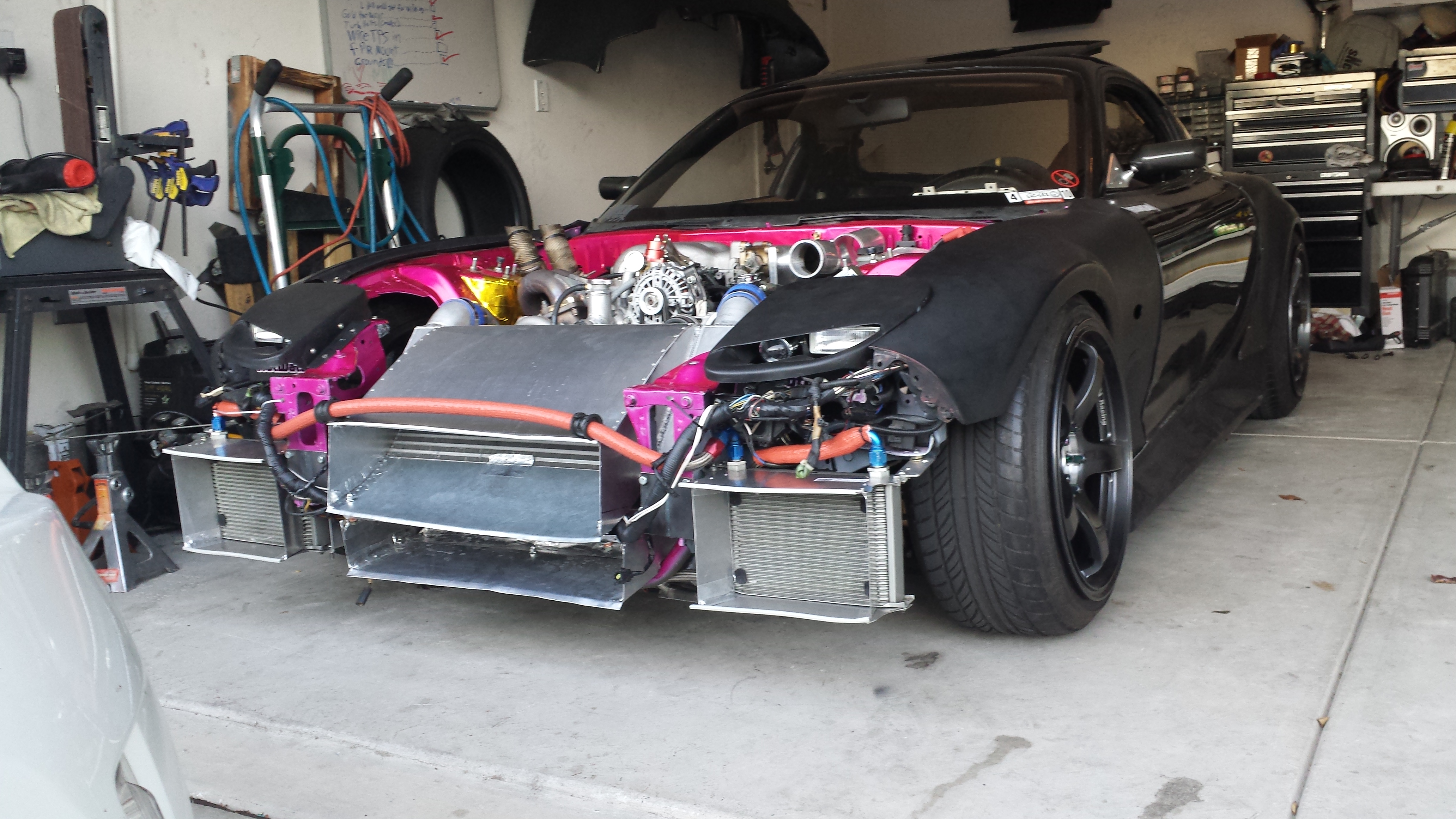
This should work great. I am more worried about the affect of the pink engine bay paint than whether the heat exchangers will work well.

I also have a horizontal mount IC which has a completely separate intake duct for radiator and intercooler as well and both exhaust into the engine bay.
Though my IC and radiator angles are more of that of a traditional V-mount.
What I do see here though is I believe from what I have read that the ducting could be further optimized.
The duct inlet opening should always be smaller in relation the volume of the duct for the reasons in my last post- recirculation rather than spillage.
If those oil cooler ducts have the large opening to match a huge bumper opening the sides of the duct should be straight to the core instead of the current angled for ram effect.
I realize the coolers downtubes are there on the sides, but they are a rounded shape that will guide the air very well without creating a duct wall shape that increases spillage out the duct opening.
The duct opening should be a little larger than the bumper opening to form a lip to recirculate the air that is rejected off the core.
If the bumper opening is much smaller than the duct opening (as would be case with most bumper covers) the duct inlet should be decreased to just over the bumper opening dimensions to form the previously mentioned lip and then the duct volume should increase rapidly as possible while keeping flow attached to a volume corresponding to the cross section of the heat exchanger core.
The same thing applies to the radiator and intercooler ducts with the added issue of heat exchanger cores angled in relation to the incoming air flow.
Again, the radiator and IC inlet duct should be wider than the bumper opening to form a lip (as previously mentioned and like the stock radiator openings black plastic air guides on each side).
Again, the volume of the duct should increase from the duct opening to match the heat exchanger core. Now that we have an angled core we have to account for the shape of the turbulence caused by air striking the angled core.
With the current IC duct the flow through the IC I would suspect at high speed the flow through the core would be very biased toward the lower part of the IC since the shallow duct to core angle up top will create a circulating turbulent mass blocking flow through the IC.
I would create a curve from the duct opening up to the top of the bumper cover and then arch it back down to meet the IC core- using as much space as possible.
If it is too cumbersome to make a duct to fit the bumper so closely, the inside surface of the bumper cover would be a perfectly acceptable top to this section of the duct provided it is well sealed.
It would likely be beneficial to add air flow straighteners on the IC core surface (curved fins ending 90 deg to core).
If the IC has a huge fan on it like the radiator the above is much less important.
If you already know this duct theory and it was just too much of a pain to implement or not worth the effort please ignore my post.
#64
Wow. Loads of good stuff here but at the same time I'm questioning some of the recommendations.
Did the OP say how much HP he is pushing? I ask because I think some of the responses are definitely tailored to high HP cars.
I run out on track and the only time I touched 100 was in WV when it was 95 degrees outside. I still run factory twins and only produce about 295-300 HP. I use a flyidyne radiator, R1 dual oil coolers and a PFS SMIC and the car runs great. Has been for three years now.
A few questions for the group: What is the proper operating temp (for water temps) for the rotary?
What is the proper operating temps for the oil in a rotary? I was always told that oil can run up to 265-275 degrees fahrenheit and it should be okay.
Also I think the transmission does get hot and that can affect the shifting so how can we keep that in check?
Did the OP say how much HP he is pushing? I ask because I think some of the responses are definitely tailored to high HP cars.
I run out on track and the only time I touched 100 was in WV when it was 95 degrees outside. I still run factory twins and only produce about 295-300 HP. I use a flyidyne radiator, R1 dual oil coolers and a PFS SMIC and the car runs great. Has been for three years now.
A few questions for the group: What is the proper operating temp (for water temps) for the rotary?
What is the proper operating temps for the oil in a rotary? I was always told that oil can run up to 265-275 degrees fahrenheit and it should be okay.
Also I think the transmission does get hot and that can affect the shifting so how can we keep that in check?
#65
"I use a flyidyne radiator, R1 dual oil coolers and a PFS SMIC and the car runs great. Has been for three years now.
Rotary Tech Tips: Water Cooling
Rotary Tech Tips: Oil Cooling Tips
These are both road conditions. I was reaching 250-ish for both water and oil (in Nov) and that did me in (having a blast in the process though)
#66
some people think it's ghetto but spraying your radiator with water actually works. But I think if you can keep your oil cool...water temps will follow (correct me if im wrong). So i'm working on a simple water bug sprayer that will have water in it. If I need a cool down...I'll simply pump and spray. The nozzles will be plumbed to each oil cooler.
4" straight through exhaust
4" straight through exhaust
Mannykiller, i am looking forward to your "ghetto" system (if it is anythingt like your ductwork)
#67
"Under normal driving conditions the water temperature should not exceed 185°F. Should the temperature reach 200°F fairly slowly, engine damage is not likely. If the rise is fairly rapid- due to a broken hose or fan belt, for example, engine damage is more likely."
"Oil temperature is critical in rotary engines. Oil temperature entering the engine should never be allowed to exceed 205°F."
#68
Just saying...
#69
The CF ducts pictured on the previous page are the CWR (Crooked Willow) ducts I referred to with my kit. No longer available, but are what kits SHOULD come with today. Duane made '99 ducts too, but they were rarely sold and I tried to buy the bucks for them at one point, but wasn't successful.

Also, I'm sorry to whomever above, but NO, canyon runs and other street driving are NOT likely to tax the cooling system anything like what the track will—especially a track with lots of WOT throttle time. I doubt you can replicate 20-40 minutes of prolonged throttle time on a public road to replicate intense circuit driving. No offense.
exactly what i was saying. sounds like a comment from someone who hasnt done any real tracking.
#70
The CF ducts pictured on the previous page are the CWR (Crooked Willow) ducts I referred to with my kit. No longer available, but are what kits SHOULD come with today. Duane made '99 ducts too, but they were rarely sold and I tried to buy the bucks for them at one point, but wasn't successful.
Also, I'm sorry to whomever above, but NO, canyon runs and other street driving are NOT likely to tax the cooling system anything like what the track will—especially a track with lots of WOT throttle time. I doubt you can replicate 20-40 minutes of prolonged throttle time on a public road to replicate intense circuit driving. No offense.
Also, I'm sorry to whomever above, but NO, canyon runs and other street driving are NOT likely to tax the cooling system anything like what the track will—especially a track with lots of WOT throttle time. I doubt you can replicate 20-40 minutes of prolonged throttle time on a public road to replicate intense circuit driving. No offense.
I guess you don't know what is going on.
When you do canyon roads at 8000-9000ft above sea level will tax your system much more so than any track at sea level or 1000ft above sea level will.
If you run any type of boost at this level you run at much higher pressure ratio's which produce more heat, you run up 5% grades, there is no OFF throttle, you have 30% less air to cool with.
So tell me, if you are running from 60mph to 120mph on a 5% grade up hill pushing 2.5 pressure ratio with 30% less cooling for 7 miles, how is any track more demanding than this at sea level?
I have read a lot of engineers posting about trucks running up mountains and blowing up engines/trannies/diffs when hauling big loads. They always blow them going up the mountains.
If you have ever noticed, rotaries cool quickly downhill and off throttle because of the fresh air cooling the engine inside out. On a steep mountain you don't have the off throttle condition.
The car when I first bought it ran great at sea level in CA. The guy drove is street mainly. I drove it back to CO and I had to stop going up the mountain 4 times going up (was going 35mph in 3rd gear) because the temps climbed like a beast. I had to redo the entire cooling system on the engine to even drive the car at this altitude, the car functioned fine at sea level even under boost. The guy never saw temps over 95C. I couldn't even drive the car here up mid grade hills in 80degree weather without it going over 100C, I had to stop driving it.
the density of air is everything.
7.5K feet vrs. sea level.
heat removal of 1.8FT^2 difference. 198HP sea level, 148HP 7.5K feet.
difference 25%.
Now run the car up a steep hill and do it quickly.
If you want to educate yourself on some cool stuff here is a link to the cooling thread on another forum.
http://www.ford-trucks.com/forums/65...-1-of-2-a.html
#71
Thread Starter
Top of the food chain!!!
iTrader: (1)
Joined: May 2005
Posts: 1,012
Likes: 45
From: North Dallas, TX
I'll most likely look to purchase a Re-medy pump
and some people think it's ghetto but spraying your radiator with water actually works. But I think if you can keep your oil cool...water temps will follow (correct me if im wrong). So i'm working on a simple water bug sprayer that will have water in it. If I need a cool down...I'll simply pump and spray. The nozzles will be plumbed to each oil cooler.
It reminds me of guys that used to have nitrous systems that sprayed on their intercooler. Always seemed like a bit of a waste but I'm sure it worked quite well. Same principle.
#72
I'd like to share what I'm running this year...
Its a modified greddy intercooler core standing vertical in front of a fluidyne radiator. The radiator ducts perfectly to the factory undertray. IC piping stays really short, uses factory fans, relay box can stay and the fan wiring doesn't even need to be extended. The radiator gets a clean shot of air from the front bumper as well as a chunk of the intercooler. Still not done with it just yet.
Ducting I intend to add: Seal off intercooler to the front support of the car. Also a little "fin" to the bottom of the intercooler to help direct airflow to it.
Do I have any idea if this will work as good as I think? Nope. But I'm willing to try it out. It will be tested on my road race fd. Sorry for the awful pictures its all I've got right now.
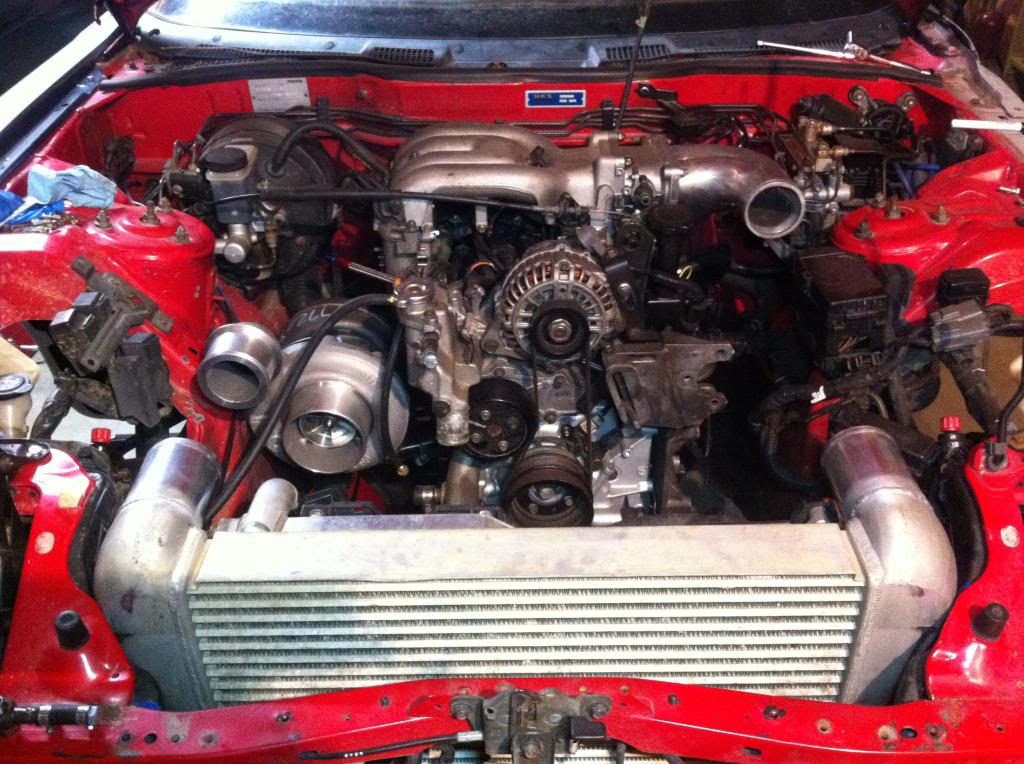
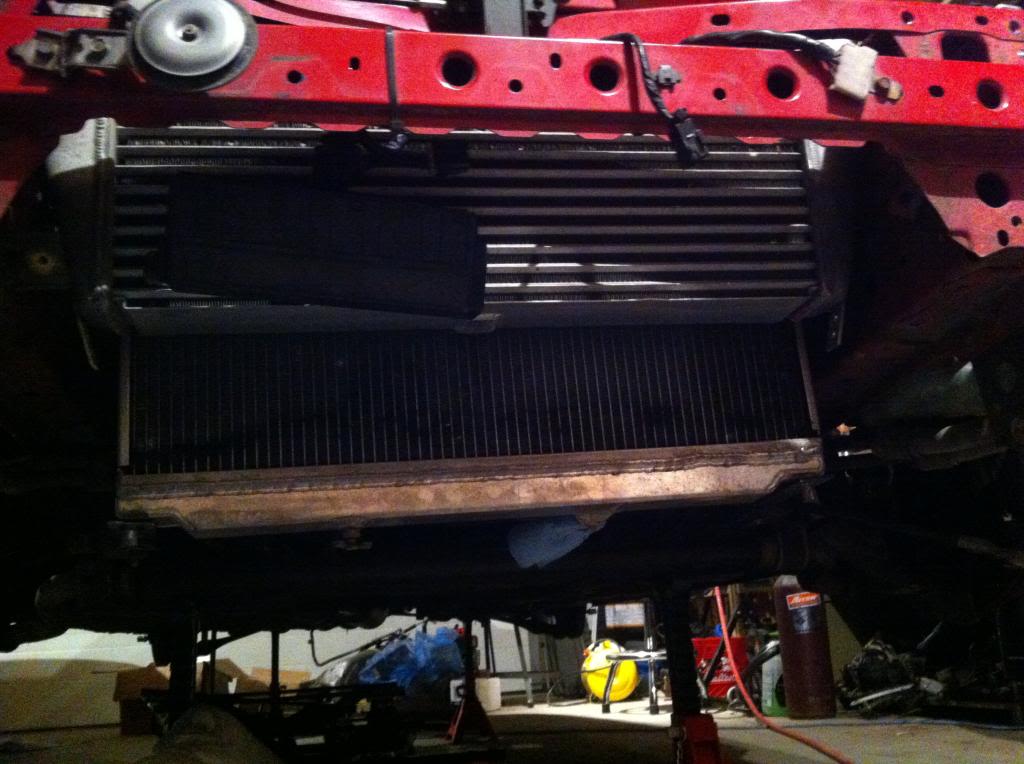
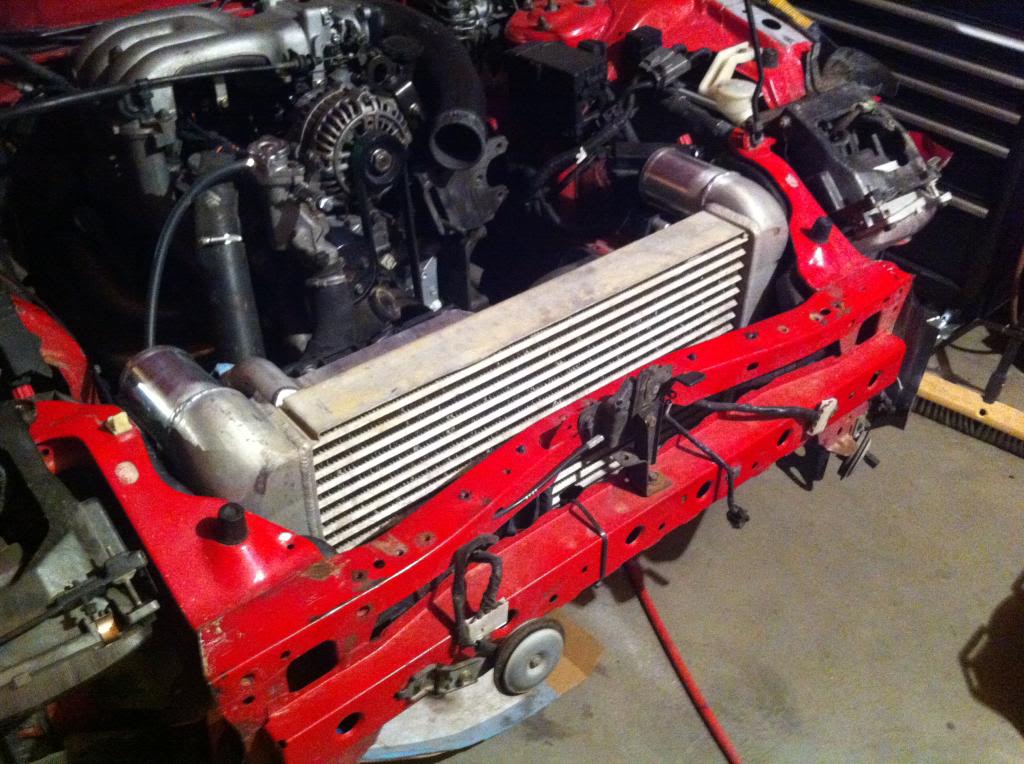
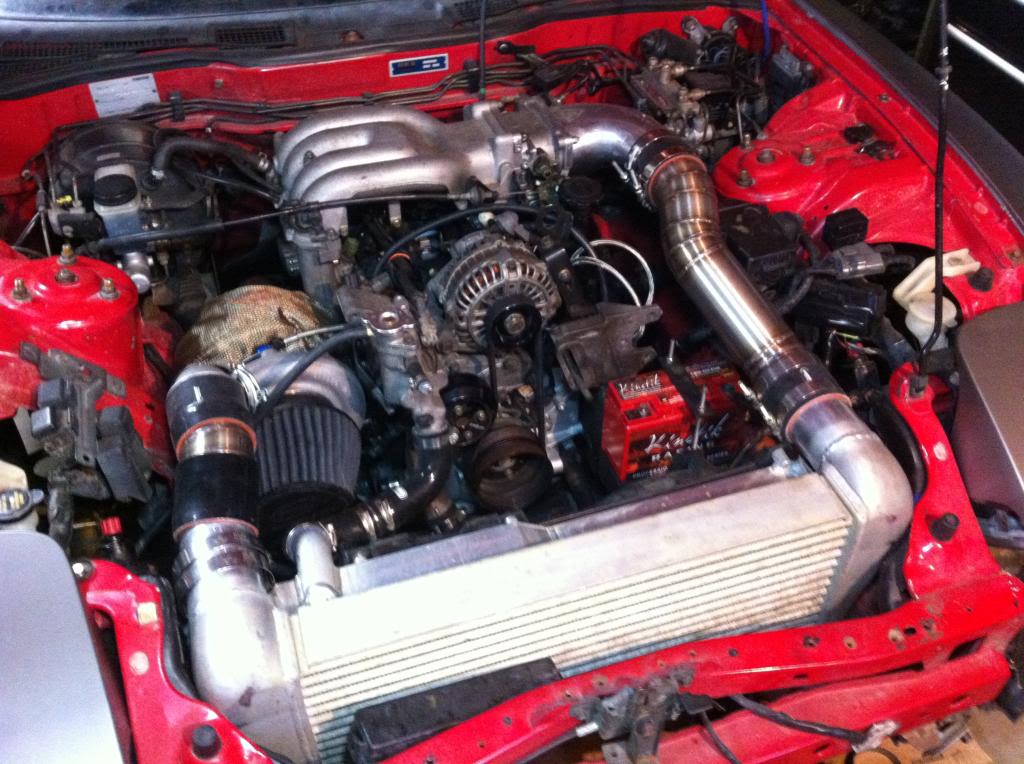
Its a modified greddy intercooler core standing vertical in front of a fluidyne radiator. The radiator ducts perfectly to the factory undertray. IC piping stays really short, uses factory fans, relay box can stay and the fan wiring doesn't even need to be extended. The radiator gets a clean shot of air from the front bumper as well as a chunk of the intercooler. Still not done with it just yet.
Ducting I intend to add: Seal off intercooler to the front support of the car. Also a little "fin" to the bottom of the intercooler to help direct airflow to it.
Do I have any idea if this will work as good as I think? Nope. But I'm willing to try it out. It will be tested on my road race fd. Sorry for the awful pictures its all I've got right now.




#73
Does anyone have material on the proper operating temps both for oil and water for the 13b? I definitely do not have a single turbo, nor do I run absurd amounts of power. I think by understanding the correct operating temps (regardless of situation) we can focus on what needs to be corrected.
Also as a side note. I was running at Watkins glen last weekend when a guy blew his motor. The cause yet to be determined but the guess is boost spike. So those guys with uprated single turbos will need to manage this for a track car.
Also as a side note. I was running at Watkins glen last weekend when a guy blew his motor. The cause yet to be determined but the guess is boost spike. So those guys with uprated single turbos will need to manage this for a track car.
#74
Normal driving conditions include going up a long hill on a warm day. A completely stock FD will easily reach water temperatures of 225 degrees, and oil temps about 20 degrees hotter. My car has a fluidyne radiator, and fans set to come on at 185. It will reach over 200 degrees water temp, and 20 degrees more for oil temp under the same conditions. Only the most modified cars with single turbos, and extreme cooling systems can stay anywhere near the temps quoted above under those conditions, and thats if they dont push it up the hill.
I guess you already know this, but 250 degrees is way too hot . Like I mentioned earlier, 230 is too hot. If you are nearing that temperature, you need to back off.
. Like I mentioned earlier, 230 is too hot. If you are nearing that temperature, you need to back off.
I guess you already know this, but 250 degrees is way too hot
 . Like I mentioned earlier, 230 is too hot. If you are nearing that temperature, you need to back off.
. Like I mentioned earlier, 230 is too hot. If you are nearing that temperature, you need to back off.


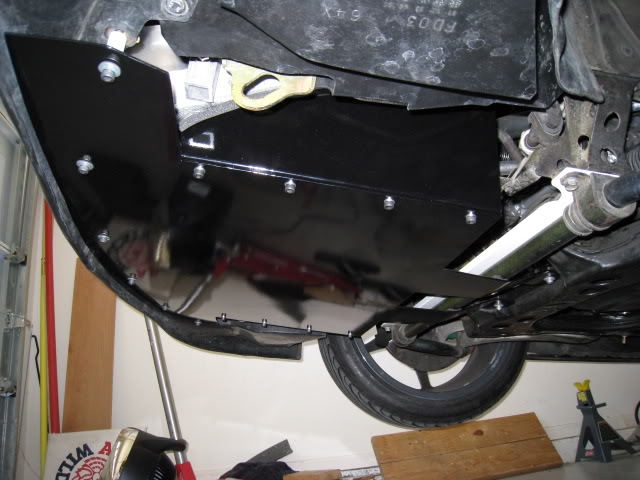
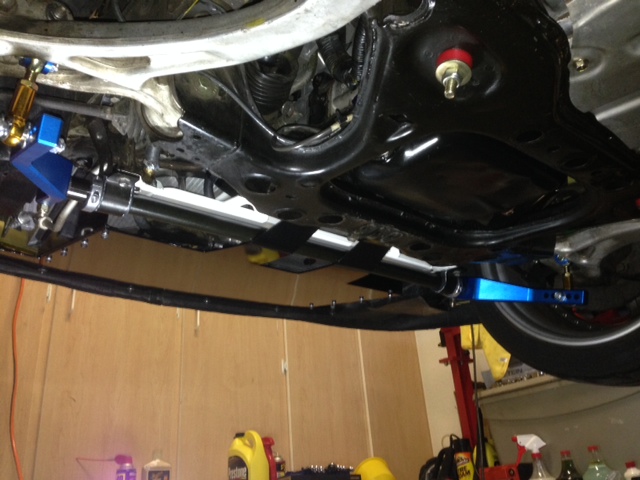
 . Tri-point front swaybar in the bottom pic is one of my "recent" purchases.
. Tri-point front swaybar in the bottom pic is one of my "recent" purchases.
